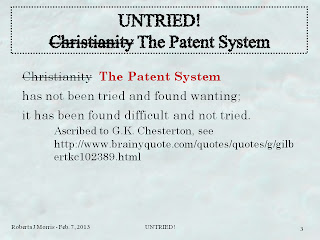non-practicing entity patent owners (NPE POs aka trolls)? Can it be that patent owners can always collect from the start of infringement as long as they do not practice the patent? Answer to both: Under the current law, YES.
In all the anti-troll fervor that pushed for the America Invents Act of 2011 (112 PL 29), did anybody propose to close the loophole? The answer seems to be NO, but I admit I haven't searched much yet.
Consider the relevant statute, 35 USC § 287(a)(as last amended effective Dec. 16, 2011)). Section 287, often referred to as the marking statute, is entitled
Limitation on damages and other remedies;
marking and notice."
marking and notice."
(Full text provided at bottom of post; numerals have been added before each sentence and the whole passage has been reformatted for ease and speed of comprehension.)
I propose that the provision concerning "Limitation on Damages" be separated from the provision describing proper marking. That is, I would leave the first sentence of 287(a) by itself, and replace the second two sentences with a new subsection that focuses on limitation of damages. Marking and damages are related but different. The loophole may well have arisen because the motivation to include the limitation on damages was to encourage people to mark their products with patent numbers, rather than to legislate a fair starting date for calculating damages. A sensible Limitation on Damages provision might say something like this:
In an action for infringement, a patentee is entitled to damages from the date on which it first provided notice of the infringement. Notice can be actual or constructive. Marking the patented product in accordance with 35 USC section 287(a) constitutes constructive notice.
I plan to write another post or two to discuss
- the historical
cases (Wine Railway (Sup. Ct. 1936), American Standard, Amsted, Texas Digital),
- the sub-loophole related to method patents (partially closed by Amsted, a 1994 case I taught when I taught basic patent law), and
- the very recent opinion that got me thinking about this problem now (SSI v. TEK, summary judgment decision of 3/7/2013). - RJM
35 USC 287(a) (reformatted, numerals inserted for each sentence)
[1]
Patentees,
and persons
making,
offering for sale, or
selling within the United States
any patented article for or under them,
or importing any patented article into the United States,
may give notice to the public that the same is patented,
either
by fixing thereon the word “patent” or the abbreviation “pat.”,
together with the number of the patent,
or by fixing thereon the word “patent” or the abbreviation “pat.”
together with an address of a posting on the Internet,
accessible to the public without charge for accessing the address,
that associates the patented article with the number of the patent,
or
when, from the character of the article, this can not be done,
by fixing to it, or to the package wherein one or more of them is contained,
a label containing a like notice.
[2]
In the event of failure so to mark,
no damages shall be recovered by the patentee in any action for infringement,
except on proof that
the infringer was notified of the infringement
and continued to infringe thereafter,
in which event damages may be recovered
only for infringement occurring after such notice.
[3]
Filing of an action for infringement shall constitute such notice.
Patentees,
and persons
making,
offering for sale, or
selling within the United States
any patented article for or under them,
or importing any patented article into the United States,
may give notice to the public that the same is patented,
either
by fixing thereon the word “patent” or the abbreviation “pat.”,
together with the number of the patent,
or by fixing thereon the word “patent” or the abbreviation “pat.”
together with an address of a posting on the Internet,
accessible to the public without charge for accessing the address,
that associates the patented article with the number of the patent,
or
when, from the character of the article, this can not be done,
by fixing to it, or to the package wherein one or more of them is contained,
a label containing a like notice.
[2]
In the event of failure so to mark,
no damages shall be recovered by the patentee in any action for infringement,
except on proof that
the infringer was notified of the infringement
and continued to infringe thereafter,
in which event damages may be recovered
only for infringement occurring after such notice.
[3]
Filing of an action for infringement shall constitute such notice.
NB: I see no reason to include sentence [3] in my proposed replacement provision. If a patentee files an action but does not serve the Complaint, then it has not given notice, it has avoided doing so. If the patentee serves the Complaint, then it has given actual notice. Am I missing something?


